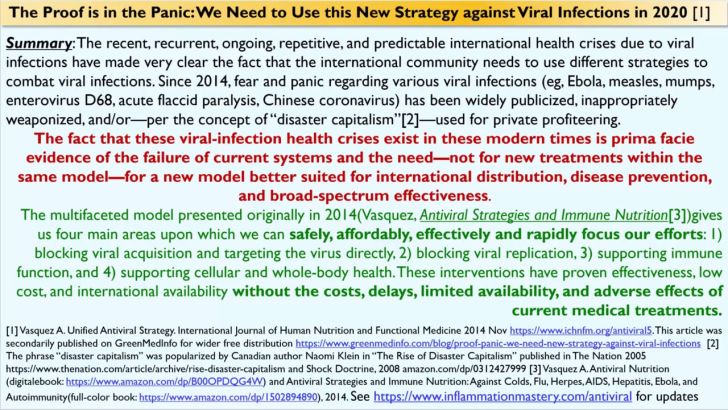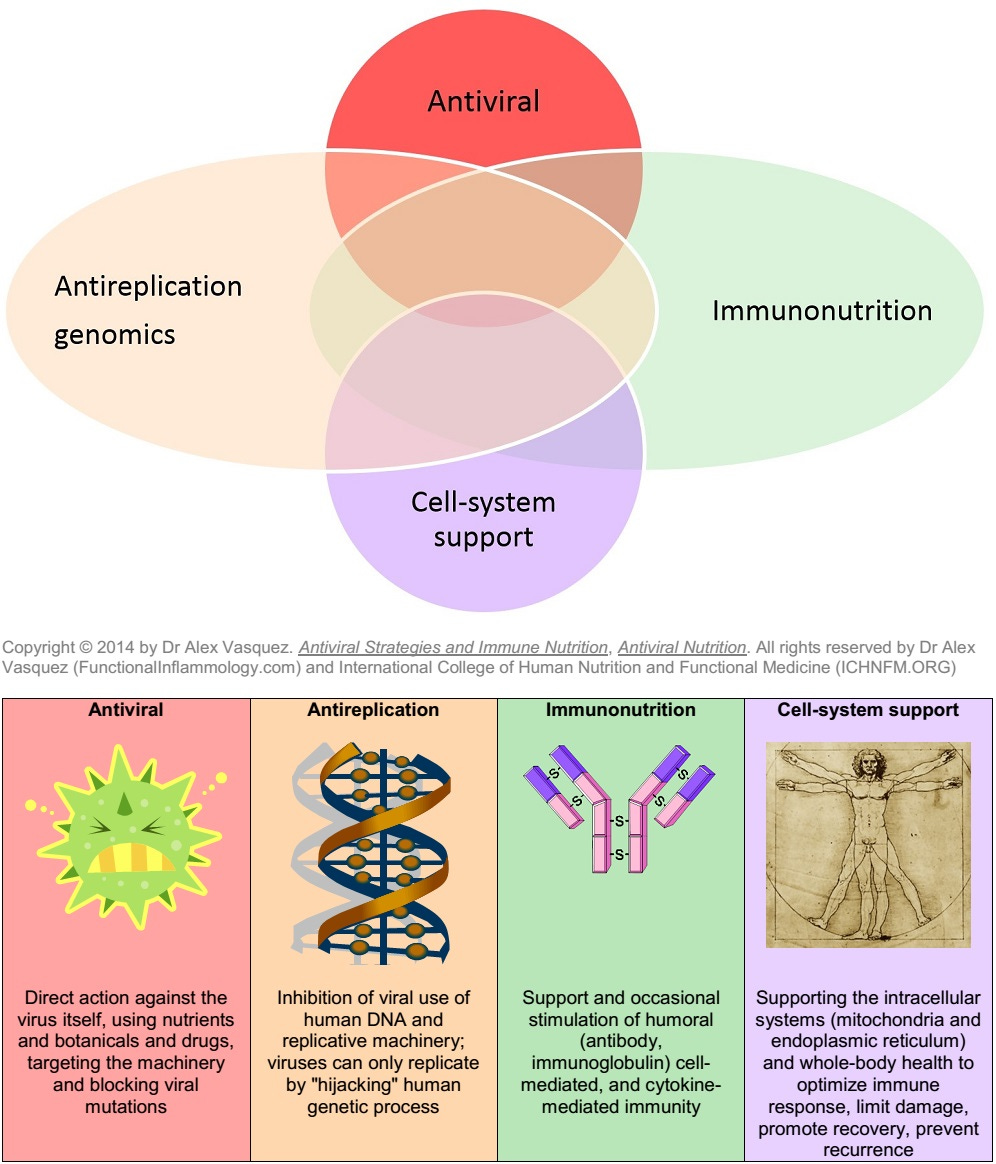Antiviral Science is Standing Still or Going Backward, but We are Clearly NOT Moving Forward: Everything I said in 2014 is Still True Today (7 years later, and counting)
Collectively and POLITICALLY, we are ignoring science and refusing to effectively combat viral infections despite an irrefutable treasure trove of confirmed evidence
Summary: The recent international health crises due to viral infections has made one thing very clear: We need a new strategy to combat viral infections.
“The fact that various panic-inducing viral-infection health crises exist in these modern times is prima facie evidence of the failure of current systems and the need—not for new treatments within the same model — for a new model better suited for international distribution, disease prevention, and broad-spectrum effectiveness. The multifaceted model presented here gives us four areas upon which we can focus our efforts: 1) targeting the virus directly, 2) blocking viral replication, 3) supporting immune function, and 4) supporting cellular and whole-body health. These are illustrated in the accompanying diagram and briefly described and exemplified in the four respective paragraphs that follow. These interventions have proven effectiveness, low cost, and international availability without the costs and adverse effects of current medical treatments.”
Sources (with references):
Original booklet/chapter publication Antiviral Nutrition, 2014: now available as a PDF download; contains the “complete” discussion and relevant diagrams
Editorial published as “Unified Antiviral Strategy” in Int J Hum Nutr Funct Med 2014 available as PDF, later re-printed as “The Proof is in the Panic: We Need a New Strategy against Viral Infections” at greenmedinfo.com/blog/proof-panic-we-need-new-strategy-against-viral-infections
History and Perspectives
What we as doctors learn in medical school about viral infections is summarized within the following course titles: Microbiology, Pathology, and Pharmacology. Following this instruction, the treatments that we use are sanitation, vaccination, and antiviral drugs, respectively. Based on training and my experience with other doctors, I suggest here that most medically-trained doctors are — at least per their formal training — unable to see beyond these blinders and limited options. What I would like to do in this article is broaden those conceptual and therapeutic horizons via a structured antiviral strategy that includes the previously mentioned sanitation, vaccination and antiviral drugs but extends beyond these limited options. Additional citations, support, and clinical details (e.g., dosing and contraindications) for this strategy are available in a digital format Antiviral Nutrition also published as a paper book titled Antiviral Strategies and Immune Nutrition (ISBN 1502894890); the purpose of this article is to structure the strategy, to shift the paradigm.
The fact that most doctors learn nothing about the science of Nutrition in medical school is well known publicly and within medical school academics [endnote 2, various citations]. Typically, most medical students read one chapter about pathologies caused by extreme nutritional deficiencies, but they learn essentially nothing about therapeutic nutrition and how it can be applied in the prevention and treatment of disease. Does ignoring Nutrition force doctors by default to over-rely on drugs and surgery? Of course it does. Would not public health be better served if information were distributed on the nutritional prevention of viral infections, so that patients and doctors alike would have more options? Of course it would.
What I have noticed through the various doctorate programs I have attended is that clinical training in the management of viral infections remains mostly phenomenalistic and enigmatic, rather than deciphered and structured. As an educator, researcher and writer, I have learned through experience to structure information in such a way that the accessibility and retention of the information is enhanced by students/readers (e.g. the DIRT, MYBESTPLAIDFIG for nutritional immunomodulation, and FINDSEX® acronyms detailed in Inflammation Mastery). My main purpose in writing this essay is to demonstrate a unique and structured antiviral strategy and to provide representative examples of its practical application.
Rather than viewing viral infections in a manner that is phenomenalistic and enigmatic, and therefore unwieldy, leading to clumsy prevention and treatment strategies, we should deconstruct the complexity of the infectious process. Doing so – at least in the manner that I have described – gives us four areas upon which we can focus our efforts: 1) targeting the virus directly, 2) blocking viral replication, 3) supporting immune function, and 4) supporting cellular and whole-body health. These are illustrated in the accompanying diagram and briefly described and exemplified in the four respective paragraphs that follow.
Image copyright © 2014, 2016, 2021 Vasquez A. digital Antiviral Nutrition also published in paper as Antiviral Strategies and Immune Nutrition ISBN 1502894890
Multicomponent Antiviral Strategy
1. Targeting the virus directly: Targeting the virus directly has been the focus of medical practice and public health efforts through sanitation, vaccination, and – more recently – the use of disease-specific antiviral drugs. Several nutrients and botanicals are also very effective for directly targeting viral infections, and I will provide two examples here. The mineral selenium has a wide margin of safety and provides antiviral benefits through several mechanisms, two of which are blocking viral mutation and also blocking viral replication; anti-infectious clinical benefits are proven in humans with HIV/AIDS.[5] The botanical medicine and common herbal tea licorice (Glycyrrhiza glabra) has demonstrated antiviral effectiveness in experimental studies and human clinical trials against several different pathogenic viruses, including hepatitis B virus (HBV), hepatitis C virus (HCV), herpes simplex virus (HSV), influenza A virus, human immunodeficiency virus (HIV-1), severe acute respiratory syndrome (SARS)-related coronavirus, respiratory syncytial virus, arboviruses, vaccinia virus, and vesicular stomatitis virus[6]; this botanical has a an excellent history of safety spanning several thousand years, with adverse/beneficial effects including a pseudoaldosterone effect (sodium retention and potassium depletion) and a testosterone-lowering effect, and mechanism of action including via direct virus binding, inhibition of viral replication, enhancement of immunity, inhibition of inflammation, and blocking the activity of specific enzymes. Antiviral nutrients and botanicals can be used alone, in combination, and alongside medications for additive and synergistic benefits.
Dr Vasquez is generously providing an entire course Antiviral Nutrition Protocol: Self-Paced Learning for subscribers at HealthyThinking.substack.com
2. Blocking viral replication: Inhibition of viral replication is the therapeutic goal of many antiviral drugs, while several nutrients can also provide a similar effect. Because viruses are unable to self-replicate and must therefore rely on host/human genetic and synthetic machinery for their replication, nutrients that modulate genetic expression can have therapeutic value here, namely via DNA methylation (generally causes genes to be "silenced") and blockade of the transcription factor NFkB (an inflammatory pathway used by viruses to promote viral replication). The few nutrients which promote DNA methylation and which also have proven clinical effectiveness against viral infections include folic acid[7] (now used clinically in the forms of folinic acid and methyl-folate), vitamin D3[8], betaine and S-adenosyl-methionine.[9] Inhibition of the NFkB pathway for antiviral effectiveness is well-proven, with two examples being with NAC against influenza[10] and lipoic acid against viral hepatitis and HIV.[11]
3. Supporting immune function: The performance and regulation of the immune system is heavily dependent on optimal nutritional status, and without proper nutrition, the immune system is slanted simultaneously toward underactivity (deficiency-induced immunosuppression) and hyperactivity manifesting as inflammation and autoimmunity.[12] Nutritional deficiencies are very common in the general population and thereby contribute to epidemics of infectious and inflammatory diseases. Human clinical trials using nutrients alone or in combination to support immune function in general have shown outstanding safety and efficacy against infectious diseases, especially use of glutamine, whey protein isolate, vitamin A, vitamin D, fish oil, and zinc.[13] Nutritional supplementation has been shown in several instances to improve immunological response to vaccinations; for example, cystine and theanine were noted to increase seroconversion of influenza vaccination in elderly persons.[14]
4. Supporting cellular and whole-body health: Viral infections have numerous adverse effects on cellular and whole-body health. Intracellular consequences of viral infections include mitochondrial dysfunction[15] and endoplasmic reticulum stress[16], manifesting clinically as prolonged inflammation, fatigue and – likely – in the case of herpes simplex infections, Alzheimer's disease.[17] Among the more than 30 interventions to improve mitochondrial function and alleviate endoplasmic reticulum stress, we see that exercise, low-carbohydrate diets, coenzyme Q-10, lipoic acid, and acetyl-L-carnitine are preeminent in their safety, effectiveness, and collateral benefits.[18] Osteopathic manipulative medicine, perhaps via promotion of improved respiration and lymphatic flow and distribution of chemokines, has also shown benefit in the nonpharmacologic amelioration of infectious disease.[19]
Dr Vasquez is generously providing an entire course Antiviral Nutrition Protocol: Self-Paced Learning for subscribers at HealthyThinking.substack.com
In summary, via the use of a structured antiviral strategy, pharmacologic and nonpharmacologic interventions can be applied with greater clinical and public health effectiveness, thereby alleviating the clinical, social, financial, and political burdens of these infectious diseases.
Conclusion and Application
The recent international outbreaks of viral infections have made one thing very clear: we need a new antiviral strategy in modern times to combat ongoing scourges of viral infections; pandemic spread of these infections in late 2014 is proof that the usual medical and public health measures of sanitation, vaccination, and medication are insufficient. The ideal antiviral strategy would be both generally and specifically effective, widely available, low-cost, with few or negligible adverse effects and drug/disease interactions. For most of medical and public health history, the tools used against viral infections have been sanitation and vaccination, with the more recent addition of molecularly-targeted antiviral drugs specific for each virus. My purpose in writing this essay is not to discuss or debate sanitation nor vaccination nor medication, but rather to point out several other intervention strategies that can be used additionally and to great patient and public health benefit. These evidence-based interventions have proven safety, effectiveness, and cost-effectiveness with wide and immediate international availability and generally negligible adverse effects and drug/disease interactions.
Publication history: The primary goal of this article is to outline a more complete strategy to counter the personal and population-wide impacts of viral infections; representative citations supporting these concepts are provided. The original article - “Unified Antiviral Strategy” in Int J Hum Nutr Funct Med 2014 - underwent legitimate peer-review by an international interdisciplinary team of professionals. Because this is a conceptual essay, citations to literature have been compiled together for efficiency.
Disclaimer: This article is not intended to provide medical advice, diagnosis or treatment.
Dr Alex Kennerly Vasquez (introduction; brief Bio-CV) writes and teaches for an international audience on various topics ranging from leadership to nutrition to functional inflammology. Major books include Inflammation Mastery, 4th Edition (full-color printing, 1182 pages, equivalent to 25 typical books [averaging 60,000 words each]), which was also published in two separate volumes as Textbook of Clinical Nutrition and Functional Medicine (Volume 1: Chapters 1-4; Volume 2: Chapter 5—Clinical Protocols for Diabetes, Hypertension, Migraine, Fibromyalgia, Rheumatoid Arthritis, Psoriasis, Vasculitis, Dermatomyositis and most other major inflammatory/autoimmune disorders); several sections have been excerpted including Antiviral Strategies and Immune Nutrition (ISBN 1502894890) (aka, Antiviral Nutrition [available as PDF download] and Brain Inflammation in Chronic Pain, Migraine, and Fibromyalgia. Dr Vasquez’s books are available internationally via bookstores such as BookDepository, Amazon.com, Barnes and Noble, ThriftBooks, AbeBooks, BetterWorldBooks, WaterStonesBooks and his new Telegram channel is https://t.me/DrAlexVasquez.




